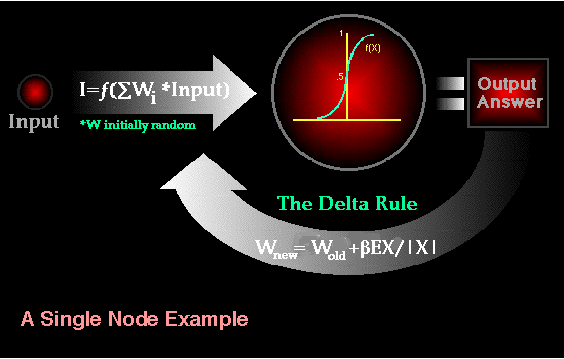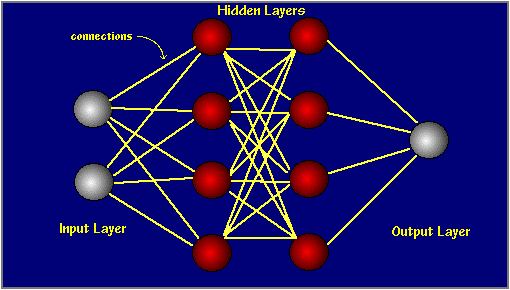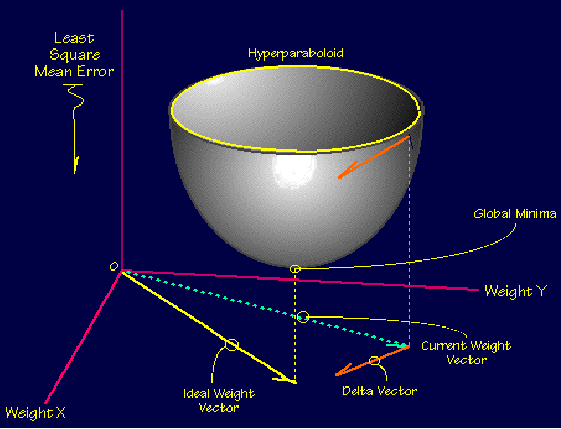




"...a computing system made up of a number of simple, highly interconnected processing elements, which process information by their dynamic state response to external inputs.ANNs are processing devices (algorithms or actual hardware) that are loosely modeled after the neuronal structure of the mamalian cerebral cortex but on much smaller scales. A large ANN might have hundreds or thousands of processor units, whereas a mamalian brain has billions of neurons with a corresponding increase in magnitude of their overall interaction and emergent behavior. Although ANN researchers are generally not concerned with whether their networks accurately resemble biological systems, some have. For example, researchers have accurately simulated the function of the retina and modeled the eye rather well.In "Neural Network Primer: Part I" by Maureen Caudill, AI Expert, Feb. 1989
Although the mathematics involved with neural networking is not a trivial matter, a user can rather easily gain at least an operational understanding of their structure and function.

Most ANNs contain some form of 'learning rule' which modifies the weights of the connections according to the input patterns that it is presented with. In a sense, ANNs learn by example as do their biological counterparts; a child learns to recognize dogs from examples of dogs.
Although there are many different kinds of learning rules used by neural networks, this demonstration is concerned only with one; the delta rule. The delta rule is often utilized by the most common class of ANNs called 'backpropagational neural networks' (BPNNs). Backpropagation is an abbreviation for the backwards propagation of error.
With the delta rule, as with other types of backpropagation, 'learning' is a supervised process that occurs with each cycle or 'epoch' (i.e. each time the network is presented with a new input pattern) through a forward activation flow of outputs, and the backwards error propagation of weight adjustments. More simply, when a neural network is initially presented with a pattern it makes a random 'guess' as to what it might be. It then sees how far its answer was from the actual one and makes an appropriate adjustment to its connection weights. More graphically, the process looks something like this:

Note also, that within each hidden layer node is a sigmoidal activation function which polarizes network activity and helps it to stablize.
Backpropagation performs a gradient descent within the solution's vector space towards a 'global minimum' along the steepest vector of the error surface. The global minimum is that theoretical solution with the lowest possible error. The error surface itself is a hyperparaboloid but is seldom
'smooth' as is depicted in the graphic below. Indeed, in most problems, the solution space is quite irregular with numerous 'pits' and 'hills' which
may cause the network to settle down in a 'local minum' which is not the best overall solution.

Since the nature of the error space can not be known a prioi, neural network analysis often requires a large number of individual runs to determine the best solution. Most learning rules have built-in mathematical terms to assist in this process which control the 'speed' (Beta-coefficient) and the 'momentum' of the learning. The speed of learning is actually the rate of convergence between the current solution and the global minimum. Momentum helps the network to overcome obstacles (local minima) in the error surface and settle down at or near the global miniumum.
Once a neural network is 'trained' to a satisfactory level it may be used as an analytical tool on other data. To do this, the user no longer specifies any training runs and instead allows the network to work in forward propagation mode only. New inputs are presented to the input pattern where they filter into and are processed by the middle layers as though training were taking place, however, at this point the output is retained and no backpropagation occurs. The output of a forward propagation run is the predicted model for the data which can then be used for further analysis and interpretation.
It is also possible to over-train a neural network, which means that the network has been trained exactly to respond to only one type of input; which is much like rote memorization. If this should happen then learning can no longer occur and the network is refered to as having been "grandmothered" in neural network jargon. In real-world applications this situation is not very useful since one would need a separate grandmothered network for each new kind of input.
In comparison, ANNs are not sequential or necessarily deterministic. There are no complex central processors, rather there are many simple ones which generally do nothing more than take the weighted sum of their inputs from other processors. ANNs do not execute programed instructions; they respond in parallel (either simulated or actual) to the pattern of inputs presented to it. There are also no separate memory addresses for storing data. Instead, information is contained in the overall activation 'state' of the network. 'Knowledge' is thus represented by the network itself, which is quite literally more than the sum of its individual components.
 For further information on neural networks on the WWW.
For further information on neural networks on the WWW.
